Bombyx mori¶
Species Information¶
Silkworms are the larva of the species Bombyx mori in the moth family: Bombycidae. This is a completely domesticated species due to silk production for 8,500 years, they would not survive in the wild today. Sericulture is the ancient practice of farming silkworms for silk production. Generally the larva are raised until they cocoon then boiled to kill the pupa inside and loosen up the silk. The cocoon is unraveled to reveal the single filament of silk spun by the worm and this is fed into a series of machinery to be woven into fabric. Silk is the only natural filament we use to make textiles.
The caterpillars body is composed of 13 segments. It has six real legs on the upper portion of its body and five pairs of false legs on the rear. Each segment has spiracle, these are the small black dot on the side of the body which the worm uses to breathe.
Lifecycle¶
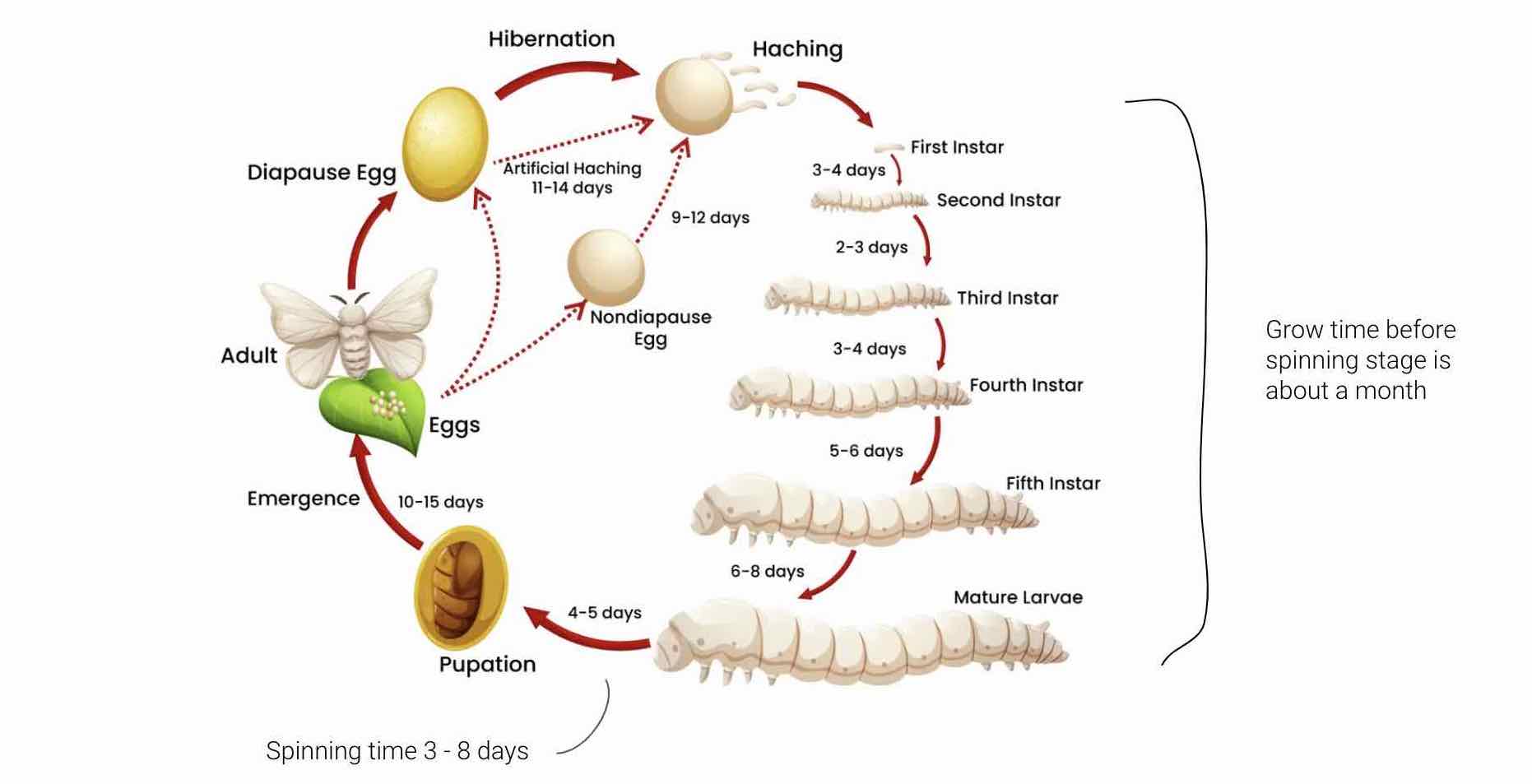
Preparation¶
Raising Bombyx mori is an exciting responsibility. Make sure you have a clean, pet free, smoke free home or lab space to cohabitate with this species.
Materials¶
| Image | Qty | Description | Price | Link | Notes |
|---|---|---|---|---|---|
 |
200 | Silkworm Eggs | 12,00 € | https://gusilandia.com/ | |
 |
500g | Mulberry Leaf Food | 26.00 € | https://gusilandia.com/ | 200g for 100 worms is recomended |
Habitat¶
- Clean a large tank or container (depending on the number of worms) it is best for the container to have a mesh lid for protection that allows oxygen to pass.
- Keep Isopropyl alcohol on hand for sterilization.
- Use gloves or tools like plastic cutlery/sticks that can be sterilized for handling the silkworms when necessary.
- Keep them a dry environment with a temperature of around 75°-88° F
- Keep them out of direct sunlight but with plenty of air flow.
Diy Plastic Box Habitat¶
I built a simple silkworm habitat from mostly second hand materials. It makes silkworm care and cleaning easier to have the worms suspended off the ground on a mesh sheet. This way their poop falls through the holes while the larva and food can stay above. The mesh frame can be removed when it is time for cleaning rather than picking up all of the larva individually and transfering them to a holding container. I lasercut a frame from mdf board and cut a mesh bbq sheet to fit a large plastic bin. I glued chopsticks to the frame to suspend it off of the ground and added two handles to the sides for removal.
| Image | Qty | Description | Price | Purchased |
|---|---|---|---|---|
 |
1 | plastic bin | x | Second hand |
 |
18x18in | plastic bbq mesh | 9.99 € | Servei Estacio |
 |
x | mdf, plywood or rods | x | Second hand |
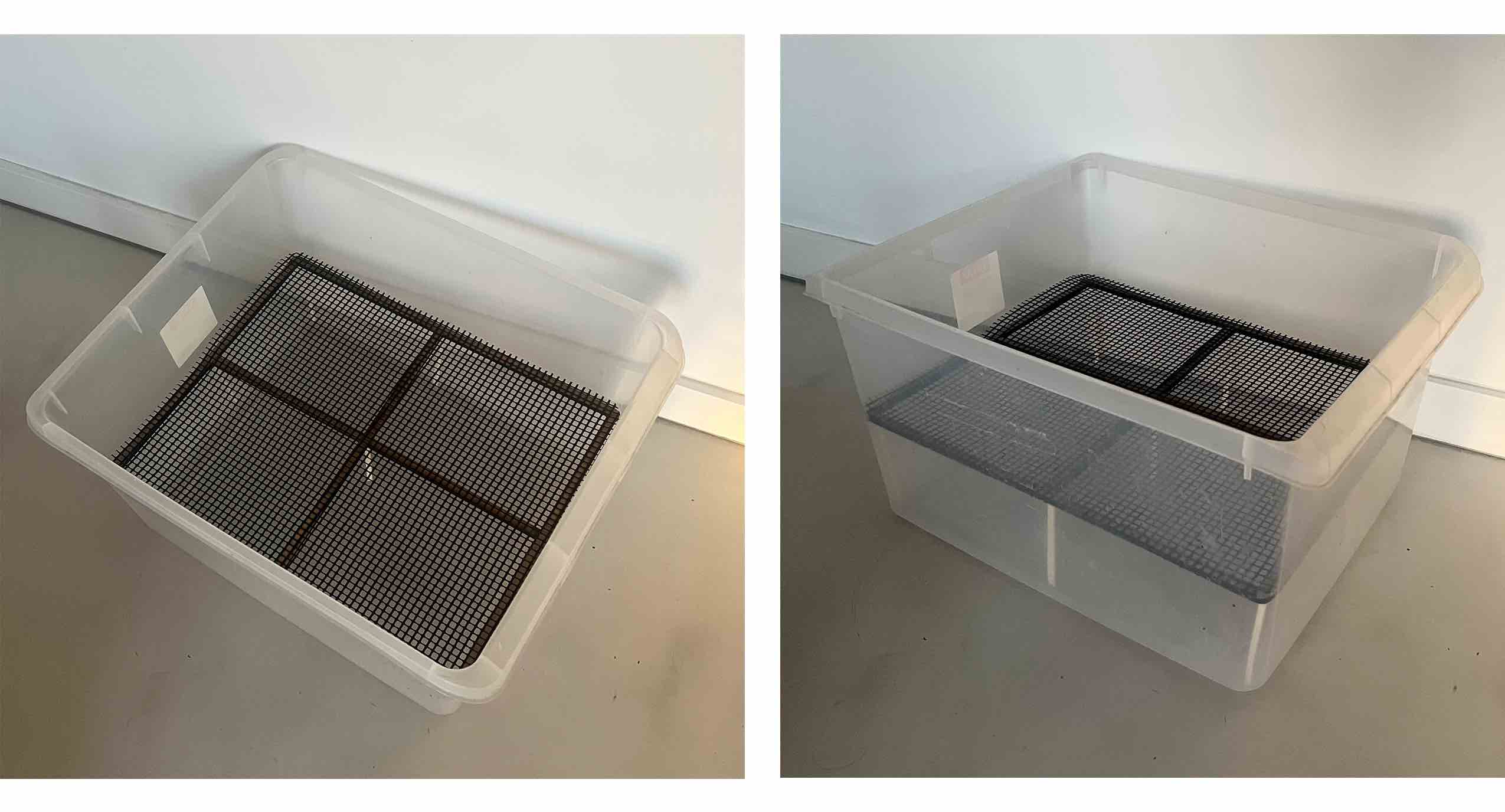
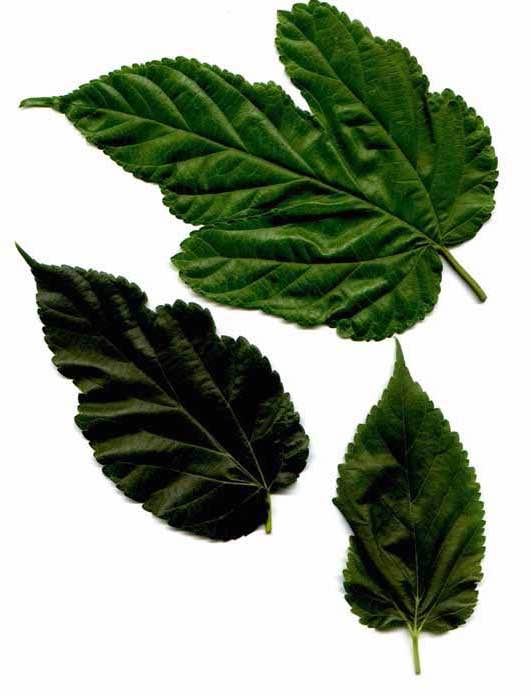
Food¶
- Silkworms only eat mulberry leaves (Morus alba)
- You will need a supply of fresh organic pesticide free mulberry leaves or powdered silkworm chow (ground leaves mixed with water)
- If you live in an area with chlorinated water you may want to use distilled water to mix the food.
- As a general guideline, you will need 2 lbs of silkworm food to raise 50 silkworms from egg to cocoon
- Fresh leaves can be held in a plastic bag in the fridge for about 5 days.
- Make sure the leaves are never dried out because they depend on the moisture for hydration
I am feeding my silkworms with powdered silkworm chow because I'm working in the winter due to the academic timeline and it is hard to come by organic mulberry leaves. I make the food by mixing a ratio of 1g powder to 3g water and microwaving until it becomes thick. Mix and let the food cool into a crumbly paste and keep it in the fridge. I let the food become room temperature again before feeding the worms.

Incubation¶
Incubation is the process of facilitating the growth and development of the embryos by providing the necessary ambience which includes the required temperature, humidity, aeration and light.
- When the eggs arrive keep them at about 50°F (in a jar in the fridge) until they are ready to hatch.
- In order to hatch you must bring them to an incubation temperature (around 68-77°F) increase the temperature gradually over a couple of days.
- After 3 to 10 days in this temperature, the worms will all emerge together in a 10 min window usually sometime in the morning.
- a small black dot will appear on the eggs which is the head of the larva, this is called pinhead stage.
- The food must be ready once the worms emerge because they will want to eat 24 hours after hatching.
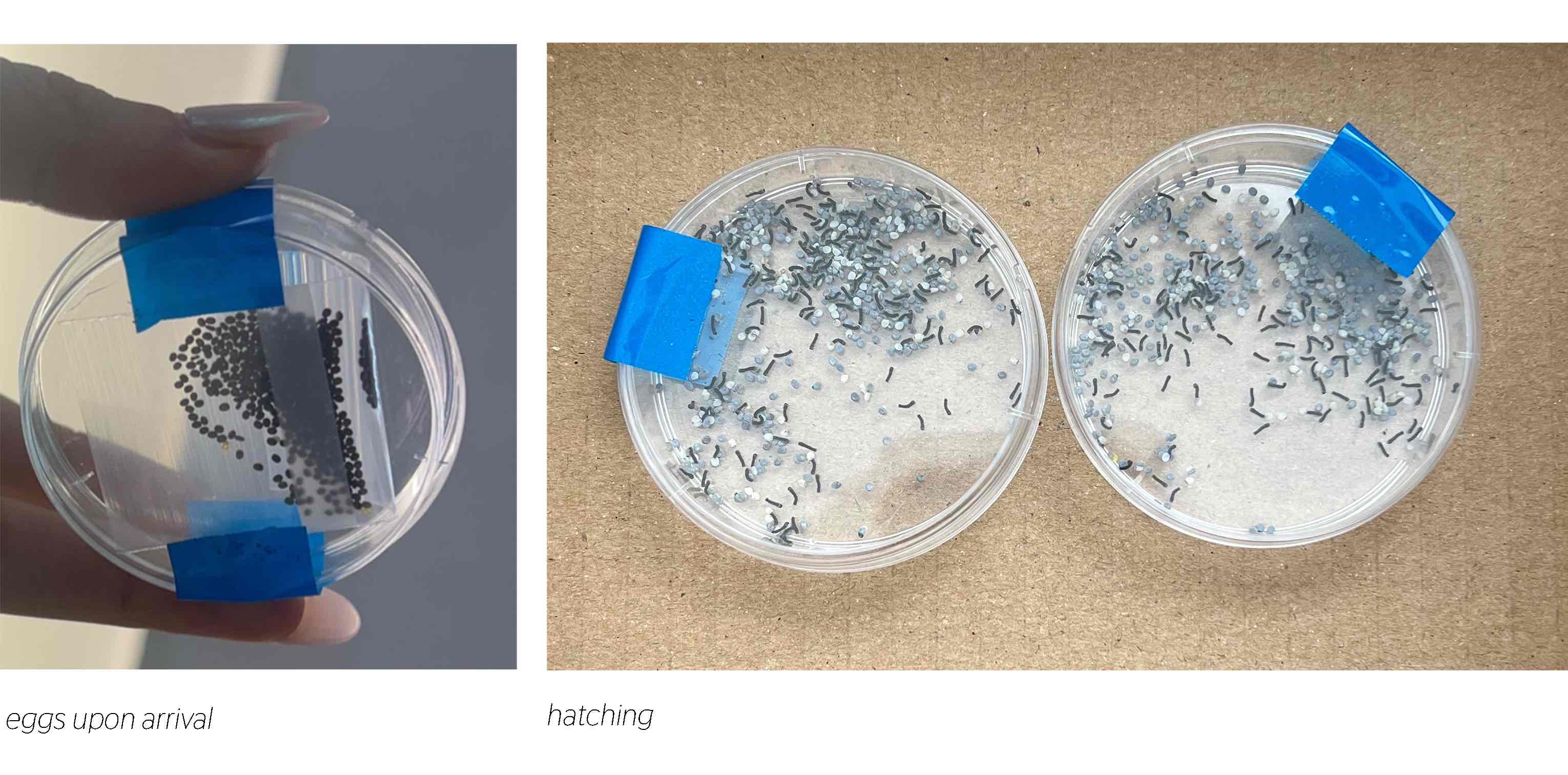
Incubation Methods¶
The most modern way of incubating the eggs is to spread them on trays on paraffin paper covered in a moist cloth in an incubator to control the temperature, humidity and light. When the temperature is high like in the summer, the eggs are incubated in earthen pots which are kept on wet sand and covered with wet cloth. Ventilation is very important as air circulation drives away the poisonous gases produced due to metabolic activity of silkworm eggs.
black boxing is a technique that slows the development of the embryos which have already reached pinhead stage, while the rest continue to develop. This way the hatching can be synchronous. The dish is covered with black paper, cloth or left in a wooden box.
The eggs hatch around 10th day after laying or two days after the pinhead stage. Bring them out of the black box and expose them to light. A piece of mosquito net or fruit mesh can be spread over the larvae and with tiny bits of food so the larvae crawl up there and away from the rest of the eggs. This makes tranportation of the tiny worms easier. The transfer of new-born larvae to the rearing tray where they are fed with the leaves is called brushing.
Raising Larva¶

- The worms will emerge very tiny, black and hairy. The Japanese name for this stage is Kego which means "hairy baby"
- When the worms are small, if you are using fresh leaves, avoid the stems and cut the softest leaves into small parts. They can be fed for 2 day inside the petri dish and then they should be transfered to a larger container.
- Generally feed the worms every morning and night but notice how much they are eating at add more or skip if necessary. The food will dry out and be wasted if it sits in the habitat without being eaten.
- Avoid moisture in the container at all costs, this can cause mold which will make the worms sick.
- The poop will build up quickly in the container and be a source of moisture. Clean the container every other day or when you sense it needs cleaning.
- Every few days the worms will molt, they tend to move away from the others and stay still with their heads raised. This can last 24 hours and they will not want to be touched or moved during this time.
- The silkworm does 80% of its eating during the fifth instar. The silk glands now make up 25% of its body weight. The larva has grown 10,000 times its size since birth, it will now be about 2 and ¾ inches long.
- After the 5th instar, the worm will prepare for spinning. You will see the worm shrink and get softer, turn more of a yellow color and let out a large poop to empty its organs for transformation.
- The worm will feel around for a corner or crevice and may begin to move its head in a figure 8 motion. It will now start to spin.
Cocooning / Spinning¶
To evaluate sex of the moth in the cocoon: males produce a peanut, hour-glass structure with somewhat pointed ends, while females are more often found in larger, oval-shaped cocoons. This is important if you want to prevent mating, seperate the cocoons according to sex. Or else you will end up with hundreds of eggs on your hands again!
More details about spinning are in the Silk tab under B. Mori Spinning Process and Data.

Pupation¶
The larva shrinks and hardens into a brown scally pupa. Usually this process happens inside the cocoon but if you are working with the mesh fabrication method you will move the shirnking larva to a safe place and observe this process. The organism is performing histolysis, self digesting their old bodies to take a new form. Velvety smooth flesh becomes hairy, 16 legs are replaced by only 6 (removal of the faux legs), and fluffy wings and hairy antennae unfold from a previously bare back and head.
Moths and Mating¶
- The Moth excretes a proteolytic enzyme called cocoonase that breaks down a hole in the silk so they can crawl out of the cocoon. It will also excrete a reddish-brown fluid shortly after emerging from the cocoon.
- Occasionally a moth will struggle with this step and need help getting out of the cocoon. You can carefully try to cut the cocoon open. This is pretty rare so generally leave the moths alone.
- Moths cannot fly, eat or drink. They mate, lay eggs, and then die within five days. After the moths emerge from the cocoon, they look for an opposite-sex moth to mate with.
- You can tell which ones are females because they are significantly larger than males. Females periodically extrude a scent gland through the hole in their abdomen. Males have a flap of skin at the end of their abdomen and in response to the smell they flutter their wings a lot. The male will flap and join its tail end to the tail end of the female moth to mate.
- Each female will lay between 200 - 500 yellow eggs, they will turn gray after fertilization. 80-85% of the eggs will hatch
- About 48 hours before hatching, a black dot appears on the eggs, this is the worm's head
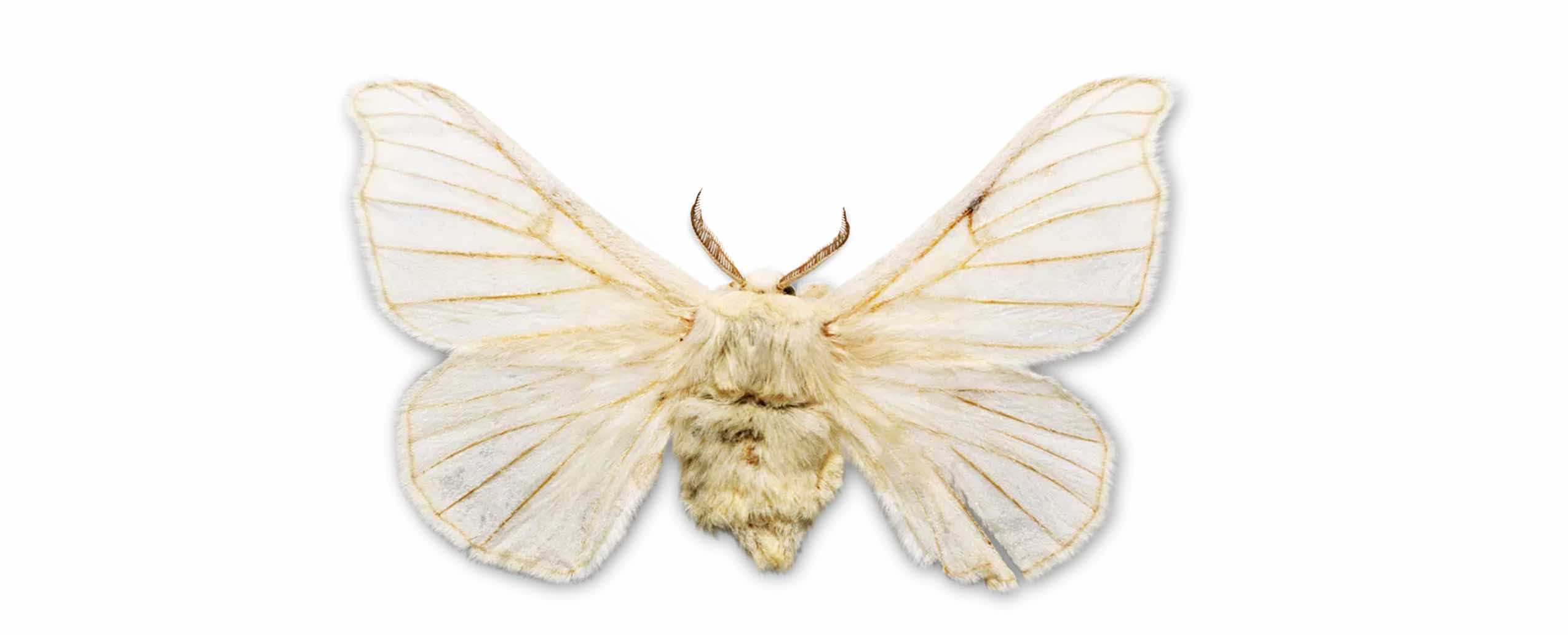
Cautions:¶
- Any other food besides mulberry leaves can kill the silkworms
- Handling the silkworms with dirty hands can pass them a disease
- Handing the worms roughly or dropping them can result in bruises or injuries
Helpful Sources¶
Mother Earth News: The Secret of Raising Silkworms
The Silkworm Shop FAQ
Sue Kayton Silkworm Blog
Egg Incubation Guide